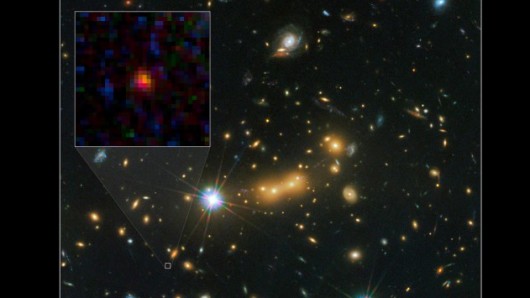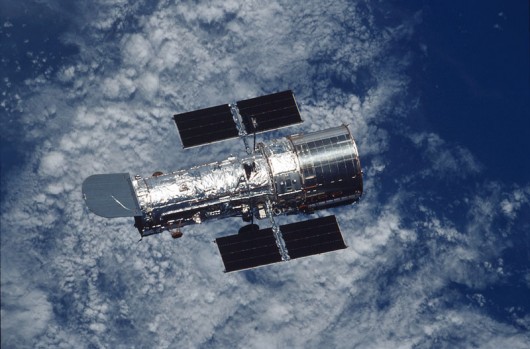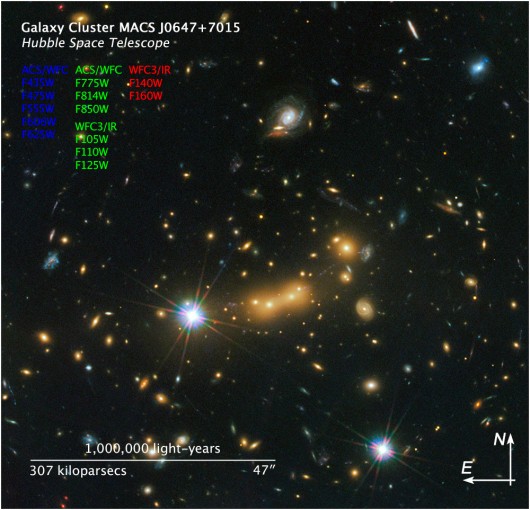
Distant galaxy lensed by Cluster MACS J0647 (Image: NASA)
MACS0647-JD was observed by the Hubble telescope, though not directly. It’s much too faint to be picked up by the orbiting observatory, so the image had to be magnified first. Between Earth and MACS0647-JD, at a distance from us of 5.6 billion light years, is a galactic cluster called MACS J0647+7015. This is made up largely of dark matter and is so massive that it bends light around itself and acts as a gravitational lens millions of light years in diameter. As the light from MACS0647-JD passed the cluster, it was magnified and split into three images - MACS0647-JD1, MACS0647-JD2 and MACS0647-JD3. These images were two to eight times brighter than the original.
Cluster MACS J0647+7015 and three magnified views of distant galaxy (Image: NASA)
MACS0647-JD was found as part of the Cluster Lensing And Supernova Survey with Hubble (CLASH), an international group led by Marc Postman of the Space Telescope Science Institute in Baltimore, Maryland. Its purpose was to do sky surveys in which gravitational lenses are used to seek objects at the furthest distances of the known universe. MACS0647JD was observed by Hubble with 17 filters, spanning near-ultraviolet to near-infrared wavelengths, but the galaxy appeared only in the telescope’s two reddest filters.
“So either MACS0647-JD is a very red object, only shining at red wavelengths, or it is extremely distant and its light has been 'redshifted' to these wavelengths, or some combination of the two," Dan Coe of the Space Telescope Science Institute said. "We considered this full range of possibilities."
The Hubble telescope (Image: NASA)
By comparing Hubble’s observations with those from the Spitzer Space Telescope the CLASH team was able to rule out red stars, brown dwarfs, and red galaxies as alternative explanations and concluded that the three images were a match for how the object would appear through the gravitational lens. The final verdict was that MACS0647-JD is an extremely distant galaxy with a huge redshift factor of 11 – the highest observed so far. Since redshift is a measure of how fast an object is speeding away from Earth and hence its distance, that places the galaxy farther away than any other object.
There’s little known about the nature of MACS0647-JD. It’s too far away for spectrography, though further observation by Spitzer and Hubble may uncover new clues as to its composition. However,some things are known. For example, MACS0647-JD is very small – only 600 light years in diameter. Our Milky Way galaxy, by contrast, is 150,000 light years across. This indicates that MACS0647-JD is, or was, a proto galaxy. It may be a small cluster of stars that was typical of the time just after the Big Bang that eventually merged with other clusters to form the familiar galaxies of today.
Compass and scale image of MACS J0647+7015
"This object may be one of many building blocks of a galaxy," said Coe. "Over the next 13 billion years, it may have dozens, hundreds, or even thousands of merging events with other galaxies and galaxy fragments."
The CLASH team will continue to search for more ancient dwarf galaxies because of the insight they provide into the early universe. They believe that if such galaxies were common they could have burned off the hydrogen fog that filled the universe then and made it transparent to light.
Source: NASA
Copyright © gizmag 2003 - 2012 To subscribe or visit go to: http://www.gizmag.com


